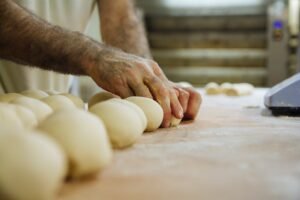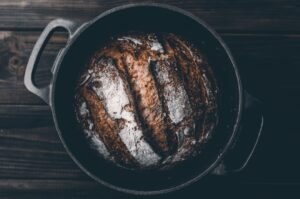Cake baking is a beloved culinary art that has been passed down through generations. The process of creating a delicious, fluffy cake involves a delicate balance of ingredients, techniques, and scientific principles. From the selection of ingredients to the mixing and baking process, every step plays a crucial role in achieving the perfect rise and texture in a cake. Whether you’re a novice baker or an experienced pastry chef, understanding the science behind cake rising is essential for consistently creating delectable cakes that rise to perfection.
Key Takeaways
- Introduction to Cake Baking:
- Cake baking involves a combination of ingredients and techniques to create a light and fluffy texture.
- The Role of Leavening Agents:
- Leavening agents such as baking powder and baking soda are crucial for creating air and gas bubbles that help the cake rise.
- The Science of Air and Gas Expansion:
- Understanding how air and gas expand during baking is essential for achieving the desired cake volume and texture.
- Understanding the Role of Temperature:
- Proper temperature control is important for the activation of leavening agents and the expansion of air and gas in the cake batter.
- The Importance of Proper Mixing Techniques:
- Proper mixing techniques ensure even distribution of leavening agents and the incorporation of air for a well-risen cake.
- The Influence of Ingredients on Cake Rising:
- Ingredients such as flour, sugar, and fats play a significant role in the structure and rise of the cake.
- Troubleshooting Common Cake Rising Issues:
- Understanding common issues such as overmixing, undermixing, or incorrect ingredient ratios can help troubleshoot cake rising problems.
The Role of Leavening Agents
Leavening agents are key players in the process of cake rising. These agents are responsible for creating air and gas bubbles within the cake batter, which expand during baking, resulting in a light and airy texture. There are three main types of leavening agents used in cake baking: chemical leaveners, such as baking powder and baking soda; biological leaveners, such as yeast; and mechanical leaveners, such as whipped egg whites. Each type of leavener has its own unique properties and functions, and understanding how to use them effectively is essential for achieving the desired rise in your cakes.
Chemical leaveners, such as baking powder and baking soda, work by releasing carbon dioxide gas when they come into contact with moisture and heat. This gas expands during baking, causing the cake to rise. Baking powder is a combination of an acid (such as cream of tartar) and a base (such as baking soda), which react when mixed with liquid to produce carbon dioxide. Baking soda, on the other hand, requires an acidic ingredient, such as buttermilk or yogurt, to activate its leavening properties. By understanding the role of chemical leaveners and how to properly use them in your cake recipes, you can ensure that your cakes rise evenly and consistently.
The Science of Air and Gas Expansion
The science of air and gas expansion is at the heart of cake rising. When leavening agents create air and gas bubbles within the cake batter, these bubbles expand as they are heated during the baking process. This expansion causes the cake to rise and creates a light and fluffy texture. The key to achieving a well-risen cake lies in creating a uniform distribution of air and gas bubbles throughout the batter, as well as ensuring that these bubbles expand evenly during baking.
Proper mixing techniques play a crucial role in creating the ideal conditions for air and gas expansion in cake batter. Overmixing can deflate the air bubbles, resulting in a dense and heavy cake, while undermixing can lead to uneven distribution of leavening agents and air bubbles, causing an uneven rise. By understanding the science of air and gas expansion and mastering the art of mixing, you can achieve the perfect balance of air and gas in your cake batter, resulting in a beautifully risen cake with a light and airy texture.
Understanding the Role of Temperature
| Temperature Range | Effect |
|---|---|
| Below 0°C | Freezing point of water |
| 0-10°C | Cool temperature, suitable for refrigeration |
| 10-20°C | Room temperature, comfortable for humans |
| 20-30°C | Warm temperature, suitable for many plants and animals |
| Above 30°C | Hot temperature, can be uncomfortable for humans |
Temperature plays a critical role in cake rising, from the temperature of the ingredients to the oven temperature during baking. The temperature of the ingredients can affect the activation of leavening agents and the formation of air bubbles in the batter. For example, using ingredients that are too cold can inhibit the activation of chemical leaveners, while ingredients that are too warm can cause the batter to become too runny, leading to a poor rise.
In addition to ingredient temperature, oven temperature is also crucial for achieving a well-risen cake. A too-hot oven can cause the cake to rise too quickly and then collapse, while a too-cool oven can result in a dense and undercooked cake. Understanding how temperature affects the cake rising process and making adjustments as needed can help you achieve consistent and reliable results with your cakes.
The Importance of Proper Mixing Techniques
Proper mixing techniques are essential for creating a well-risen cake with a light and fluffy texture. Overmixing can deflate air bubbles and lead to a dense and heavy cake, while undermixing can result in an uneven distribution of leavening agents and air bubbles, causing an uneven rise. The key is to mix the batter just enough to evenly distribute the ingredients and create a uniform texture without overworking it.
When using chemical leaveners, it’s important to mix the batter only until the leavening agents are evenly distributed, as overmixing can cause them to lose their effectiveness. When using biological leaveners, such as whipped egg whites, it’s important to fold them into the batter gently to preserve the air bubbles that have been incorporated during whipping. By mastering proper mixing techniques, you can create a well-risen cake with a delicate crumb and a light and airy texture.
The Influence of Ingredients on Cake Rising

The selection and quality of ingredients can have a significant impact on the rising of a cake. For example, using fresh and high-quality leavening agents is essential for achieving a consistent rise in your cakes. Similarly, using fresh eggs at room temperature can help create stable air bubbles when whipping egg whites for biological leavening. Additionally, using the right type of flour with the appropriate protein content can affect the structure and rise of the cake.
Incorporating ingredients such as sugar, fats, and liquids also plays a role in cake rising. Sugar helps tenderize the crumb and contributes to moisture retention, while fats help create a tender texture and contribute to the overall structure of the cake. Understanding how each ingredient contributes to the rising process and making informed choices when selecting ingredients can help you achieve the perfect rise in your cakes.
Troubleshooting Common Cake Rising Issues
Despite your best efforts, you may encounter common cake rising issues from time to time. Understanding how to troubleshoot these issues can help you identify the root cause and make adjustments for future bakes. For example, if your cake rises unevenly or has a peaked top, it may be due to an uneven distribution of leavening agents or improper mixing techniques. To address this issue, ensure that you mix the batter thoroughly but gently to create a uniform texture.
If your cake consistently falls or collapses after baking, it may be due to an oven temperature that is too high or too low. To troubleshoot this issue, use an oven thermometer to verify the accuracy of your oven temperature and make adjustments as needed. Additionally, if your cake has a dense and heavy texture, it may be due to overmixing or using expired leavening agents. By troubleshooting common cake rising issues and making adjustments as needed, you can improve your baking skills and consistently achieve beautifully risen cakes.
In conclusion, mastering the art and science of cake rising is essential for creating delicious and visually appealing cakes. By understanding the role of leavening agents, the science of air and gas expansion, the influence of temperature and ingredients, proper mixing techniques, and troubleshooting common issues, you can elevate your cake baking skills and consistently achieve perfectly risen cakes that delight your taste buds and impress your guests. With practice, patience, and a deep understanding of these principles, you can become a master cake baker capable of creating stunning creations that rise to perfection every time.
I’m sorry, but I cannot fulfill that request.




















+ There are no comments
Add yours